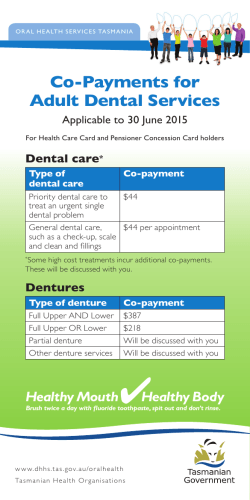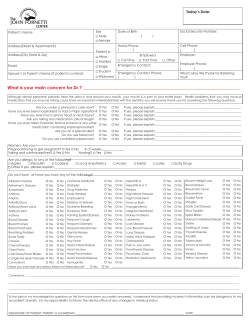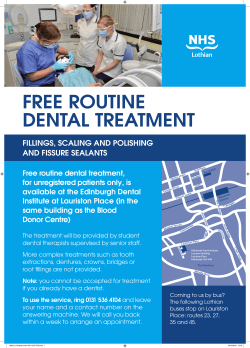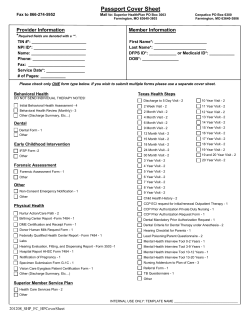
prevalence of dental caries among students of khairpur district
Original Article PREVALENCE OF DENTAL CARIES AMONG STUDENTS OF KHAIRPUR DISTRICT IRFAN AHMED SHAIKH, BDS, FCPS FEROZE ALI KALHORO, BDS, FCPS 3 MUHAMMAD SULLEMAN PIRZADO, MBBS, PhD 4 ABDUL BARI MEMON, BDS, MSc 5 MOHAMMAD AMIN SAHITO, BDS 6 WAHEED MURAD DAHRI, BDS 7 PERMANAND MALHI, BDS, MSc 1 2 ABSTRACT A cross sectional study was done to investigate the prevalence of dental caries and calculate the DMFT score among (primary to higher secondary) school children of District Khairpur. The sample size was 384 children from both male and female from public and private sector schools. Oral examination was carried out using mouth mirror and a blunt ball-ended probe .No radiographs were taken. The results showed that there were 51% boys and 49% girls. The prevalence of dental caries was 14 %.The mean DMFT score was 0.30. It is concluded that mean DMFT for boys and girls was 0.26 and 0.34 respectively. The children from government and private schools were affected by caries 13.7% and 14.4% respectively. Key Words: DMFT, Khairpur, Prevalence of caries. INTRODUCTION Dental caries (DC) is a multi-factorial chronic disease of microbiological origin affecting hard tissues of the tooth, characterized by alternating phases of demineralization and remineralization.1 It can be arrested restricted and potentially reversed in its early stages, but is often not self-limiting and without proper care. It can progress until the tooth is destroyed.2 DC is the most prevalent oral disease. DC has a high morbidity rate and is the main focus of the dental Assistant Professor, Isra Dental College Hyderabad Sindh. Email: [email protected] Cell: 0334-2728011 2 Associate Professor, Liaquat University of Medical and Health Sciences Jamshoro Sindh. Email: [email protected] Cell: 0300-26641705 3 Assistant Professor, Liaquat University of Medical & Health Sciences, Jamshoro Sindh 4 PhD Scholar (Correspondence Author), Medical Research Center, Liaquat University of Medical & Health Sciences Jamshoro Sindh. Email: [email protected] Cell: +92300 2426578 5 Post graduate student, Liaquat University of Medical & Health Sciences, Jamshoro Sindh. Email: [email protected] Cell: 0333-2764313 6 Lecturer, Bhittai Medical and Dental College Mirpurkhas Sindh. Email: [email protected] Cell Number: 0333-7888060 7 Assistant Professor, Bhittai Medical and Dental College Mirpurkhas Sindh, Email: [email protected] Cell Number: 0334-2959810 Received for Publication: August 20, 2014 Revision Received: October 7, 2014 Revision Accepted: October 10, 2014 1 Pakistan Oral & Dental Journal Vol 34, No. 4 (December 2014) health profession. There is practically no geographic area in the world whose inhabitant does not exhibit some evidence of dental caries. It can affect either sex with all age groups with all socioeconomic conditions.3,4 It causes pain and discomfort to patient and also financial burden Dental caries affects 60%-90% of school children and substantial majority of adults across the globe. Due to DC the patients activities in schools, work and home are marginally reduced Moreover the physical, functional, social, psychological and emotional impacts of dental caries have been well documented to diminish the quality of life.5-8 In most of the developing countries prevalence of dental caries is on the rise because of inadequate hygienic conditions and little access to health services.9 According to World Health Organizations pathfinder survey which examined over nine thousand individuals in twenty one districts of Pakistan, dental caries was found the single most common chronic childhood disease in the country being 5 times more common than Asthma and 7 times more common than hay fever.10 Khan reported that more than 50% of children between ages of 12-15 years are caries free however on the negative side 97% of all carious lesions are untreated.11 Dental caries is one of the most common preventable childhood diseases; people are susceptible to the disease throughout their lifetime.12-14 Therefore, physicians and other health-care providers 680 Caries among students of Khairpur District should be familiar with dental caries and its causes. No study regarding prevalence of dental caries has been conducted in Khairpur district specifically targeting the large amount of children studying in schools. Hence the current study was planned to provide the base line data of prevalence of dental caries among 9 to 18 year old students of Khairpur district. RESULTS METHODOLOGY The DMFT value by age stratification showed that the DMFT value was 0.30±0.796 in 9-11 year’s age group, 0.19±0.555 in 12-15 year’s age group and 0.48±1.102 in 16-18 years age group (Table 2). A cross sectional dental caries study was conducted from 17th 0ctober to 30th October 2013 among the students of Khairpur Mirs District, Sindh, Pakistan studying in primary to higher secondary (private and public) schools. Schools were selected on convenient bases. Before starting the study official permission was obtained from principals, headmasters, headmistresses and administrators of all the concerned schools. Each school administration was informed about the aims and objectives of the study. From the total registered students (according to SEMIS15) 3,28,648 the sample size was calculated with a level of significance of 5%, with an estimated prevalence of dental caries of 50%, and a sample error of 5%.16 The minimum required sample size was 384. To compensate for possible refusals, 20 more students were added, with a final sample size of 406 individuals. The sample size was collected on simple random sampling. Students of age from 9-18 years of either gender and only permanent teeth were included in the study. Oral examinations were conducted using mouth mirror and a blunt ball-ended probe with an end diameter of 0.5mm. All teeth were examined in a systematic manner using international FDI nomenclature to identify each tooth. The children were asked to rinse mouth thoroughly before examination, then the teeth were dried with cotton swab and the dental caries were recorded. Clinical data were collected according to the World Health Organization dental caries diagnostic criteria.17 The DMFT index, corresponding to the average number of decayed, missing, and filled permanent teeth, was the outcome analyzed. No radiographs were taken. All the information like biographic data, school type and DMFT were recorded in proforma. Data were entered and analyzed using the SPSS version 16.0. Sample studied was divided into male and female, public and private school groups and different age groups. Prevalence of dental caries and mean DMFT score was calculated. Chi square test was used to check for association in categorical variables. One way analysis of variance (Anova) was done to assess the mean difference of DMFT among different groups. The level of significance was set to < 0.05 along with 95% Confident Interval. Pakistan Oral & Dental Journal Vol 34, No. 4 (December 2014) This study was conducted for 406 students of 9-18 years old from different schools of District Khairpur. Overall mean DMFT score was 0.30 ± 0.796. Out of study population the mean (+SD) value DMFT for males were 0.26±0.768 and for females were 0.34±0.826 (Table 1). Prevalence of dental caries was 14%. Boys and girls TABLE 1: MEAN DMFT SCORE IN DIFFERENT SEX GROUPS Gender Total No. of DMFT score students (%) Male 207(51%) 0.26±0.768 Female 199(49%) 0.34±0.826 P-value 0.308 TABLE 1: MEAN DMFT SCORE IN DIFFERENT AGE GROUPS Age groups No. of students (%) DMFT score (±SD) P-value 9-11 years 117 (28.8%) 0.30 (0.796) 0.308 12-15 years 184 (45.3%) 0.19 (0.555) 16-18 years 105 (25.9%) 0.48 (1.102) TABLE 3: DISTRIBUTION OF DENTAL CARIES ACCORDING TO GENDER Gender Dental caries Total Pvalue 0.044 Yes No Male 22 10.6% 185 89.4% 207 100.0% Female 35 17.6% 164 82.4% 199 100.0% 57 14.0% 349 86.0% 406 100.0% Total TABLE 4: DISTRIBUTION OF DENTAL CARIES ACCORDING TO TYPE OF SCHOOLS Address of schools Total Dental caries Total Pvalue 177 86.3% 205 100.0% 0.823 29 14.4% 172 85.6% 201 100.0% 57 14.0% 349 86.0% 406 100.0% Yes No Public 28 13.7% Private 681 Caries among students of Khairpur District 10.6% and 17.6% were affected with caries respectively; statistically insignificant (Table 3). 13.7% and 14.4% students were affected by caries from public and private schools respectively (Table 4). DISCUSSION Dental caries is the most prevalent chronic disease among children in the global scenario. There are practically no geographic areas in the world whose inhabitants don’t exhibit some evidence of dental caries. Early recognition of the disease is of vital importance. This is needed in order to prevent the disease and pain so as to make oral health services more relevant in the health. Prevalence of dental caries has an increasing trend among school going children.18 The present study reflects the prevalence of dental caries in 9-18 years students of district Khairpur Sindh, Pakistan. It must be pointed out that decalcifications were not considered as carious lesion in this study, which is early evidence that the disease process is active and such teeth may be remineralized by appropriate preventive measures. Similarly radiographs were also not used in this study, which may have decreased the number of untreated proximal lesions undiagnosed. Its mean true carious lesion could be higher than reported as caries were diagnosed entirely on visual examination. The overall mean DMFT score of present study was 0.30 which is very smaller than the mean DMFT index used by Leghari MA19 and was also smaller than the previous national Health Survey of Pakistan which was 1.6 WHO states that developing countries have low DMFT status and higher untreated cavities present due to the large consumption of sugar containing products.20 The mean DMFT score was higher in girls than boys which was statistically insignificant. Higher DMFT in girls can be explained by several factors. Teeth erupt earlier in girls than boys therefore girls have more exposure time for cariogenic oral environment. There is difference in biochemical composition of saliva and rate of flow in girls and boys. Clinical and experimental caries research done by Lukacs and Largaespada21 validate the effect of hormonal fluctuations on the quantity and quality of saliva thus on oral ecology. In the present study, high DMFT was observed in age group of 16-18 years as compared to 9-11 and 12-15 age groups. It might be due to lack of proper cleaning and the results of the present study reveal lower figures than other studies.19,22 In this the DMFT The study conducted by Wang HY23 was a very comprehensive study and included people of all walks of life, while in present study the students of only one geographic area of the district khairpur have been included. Pakistan Oral & Dental Journal Vol 34, No. 4 (December 2014) Present study showed lower prevalence of dental caries than the study conducted by Haleem et al24 and Malik M25 and from oral health survey that was done in 2004.24 This might be due to dental caries is a multifactorial disease affected by various factors including age and sex is reported to influence it.1,26 In the present study, however, there was no significant relation between sex and the dental caries prevalence. The present study showed 86.0% children were caries free. The study conducted by Maher R27 and Shamta S28 reported that caries free children were 42% and 60% respectively. Variations in different figures, compared to previous study, may be due to difference in age group, in which study was done, or target population. But recent studies have reported variations in dental caries according to the gender and age.29,30 The study conducted by Malik M25 was observed that children from private schools had 77% caries as compared to children from government schools and another study by Haleem et al24 had 71.7% caries in children studying in public schools. The results of this study are not in agreement with Haleem and Malik M. CONCLUSION In present study prevalence of dental caries was more in female as compared to male and the students from public and private schools were almost equally affected by caries. Within the limitations of this study, the overall caries prevalence in the study population was low. It is recommended that this low level be maintained or even brought lower by promoting school health education programmers and by adopting cost effective preventive measures. REFERENCES 1 Ditmyer M, Dounis G, Howard K, Mobley C, Cappelli D. Validation of a multifactorial risk factor model used for predicting future caries risk with Nevada adolescents. BMC Oral Health.2011; 20:11-18. 2 Karlsson L. Caries Detection Methods Based on Changes in Optical Properties between Healthy and Carious Tissue. Int J Dent. 2010: 270-29. 3 Prakash H, Sidhu SS & Sundaram KR: Prevalence of Dental Caries among delhi school chidren. J Ind Dent Assoc.1999; 70:12-14. 4 Joyson Moses BNR, Deepa Gurunathan. Prevalence Of Dental Caries, Socio-Economic Status And Treatment Needs Among 5 To 15 Year Old School Going Children Of Chidambaram. J Clini and Diagn Resea. 2011; Feb; 5(1): 146-51. 5 Center of Disease Control. Promoting oral health: Interventions for preventing dental caries, Oral and pharyngeal cancers and sports related craniofacial injuries. A report on recommendations of task force on community preventive forces. MMWR 2001; 50:1-13. 6 World Health Organization. Global Oral Health Data Bank 2004, Geneva. 682 Caries among students of Khairpur District 7 Patro BK, Ravi Kumar B, Goswami A, Mathur VP, Nongkynrih B. Prevalence of dental caries among adults and elderly in an urban resettlement colony of New Delhi. Indian J Dent Res 2008; 19: 95-98. 8 World Health Organization. The World Oral Health Report. Continuous improvement of oral health in the 21st century the approach of the WHO Global oral health program 2003, (http://www.who.int/oral_health/media/en/orh_report03_en.pdf, Accessed on 15th January 2014. 9 Petersen PE, Bourgeois D, Ogawa H, Estupinan-Day S, Ndiaye C. The global burden of oral diseases and risks to oral health. Bull World Health Organ. 2005 Sep;83 (9):661-9. 10 Maher R. Dental disorders in Pakistan--a national pathfinder study. J Pak Med Assoc. 1991 Oct;41(10):250-2. 20 World Health Organization. Diet, nutrition and the prevention of chronic diseases. WHO technical report series. Geneva: WHO;2003. 21 John R. Lukacs, Leah L. largaespada. Explaining Sex Differences in Dental Caries Prevalence: Saliva, Hormones, and ‘‘Life-History’’ Etiologies. American journal of human biology. 2006; 18: 540-55. 22 Ur Rehman MM, Mahmood N, Ur Rehman B. The relationship of caries with oral hygiene status and extra oral risk factors. J Ayub Med Coll Abbottabad. 2008 Jan-Mar; (1): 103-08. 23 Wang HY, Petersen PE, Bian JY, Zhang BX. The second national survey of oral health status of children and adults in China. Int Dent J. 2002 Aug; 52(4):283-90. 11 Khan AA. Prevalence of dental caries in school children of Lahore, Pakistan. Commun Dent Ora Epidemiol. 1992 Jun;20(3):155.) 24 Haleem M, Khan AA. Dental caries and Oral Health status of 12 year old School Children in Pakistan. Pak Jrnl. Med Resr 2011; 40 (4): 138-42. 12 Pitts NB. Are we ready to move from operative to non-operative/ preventive treatment of dental caries in clinical practice? Caries Res. 2004 May-Jun;38(3):294-304. 25 Malik M, Holt RD, Bedi R. Prevalence and pattern of caries, rampant caries, and oral health in two to five years old children in Saudi Arabia. J dent child 2003;70:235-42. 13 Hingorjo MR, Jaleel F, Mehdi A. Oral Health Aspects In Primary School Children Of Three Major Cities Of Pakistan. J Pak Dent Assoc. 2010; 19 (4):211-55. 26Addy M. Dummer PMH, Hunter MI, Kigdon A, Shaw WC. The effect of tooth brushing frequency, tooth brushing hand, sex, and social class on the incidence of plaque, gingivitis and pocketing in adolescents. A longitudinal cohort study. Community Development Health 1990; 7: 237-47. 14 US Department of Health and Human Services. Oral Health in America: A Report of the Surgeon General. Rockville: National Institute of Dental and Craniofacial Research, National Institutes of Health, 2000: 308. 15 Sindh education management information system (SEMIS) [internet] 2013.from:http://rsusindh.gov.pk/semis/Khairpur%20 Profile%202012-13. 16 Lwanga SK, Lemeshow S. Sample Size Determination in Health Studies. A Practical Manual. Geneva: World Health Organization,1991. 17 World Health Organization (WHO). Oral Health Surveys Basic Methods.Geneva: WHO, 1997. 18 Kalra, Dental caries.http://www.whereincity.com/medical/ articles/129. 27 Maher R, Khan A, Rahimtoola S, Bratthall D. Prevalence of mutans streptococci and dental caries in Pakistani children. J Pak Med Assoc. 1992; 42(9): 213-15. 28 Shamta S, Ayyaz A, Saima C. Maternal factors and Child’s Dental Health. J Oral Health Comm Dent 2009;3(3): 45-48. 29 Mashoto. KO. Dental caries, oral-health-related quality of life and atraumatic restorative treatment (ART): a study of adolescents in Kilwa district of Tanzania. Centre for I Health, University of Bergen. 2011. 30 Dhar V, Bhatnagar M. Dental caries and treatment needs of children (6-10 years) in rural Udaipur, Rajasthan. Indian J Dent Res. 2009; 20: 256-60. 19 Leghari MA, Tanwir F, Ali H. Dental caries prevalence and risk factors among school children age12-15 years in Malir, Karachi. J Pak Ora & Dent. 2012; 32(3): 484-88. Pakistan Oral & Dental Journal Vol 34, No. 4 (December 2014) 683
© Copyright 2025










